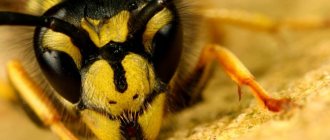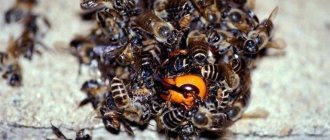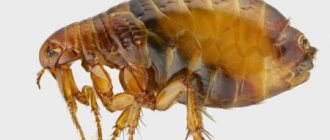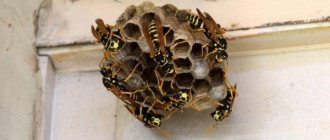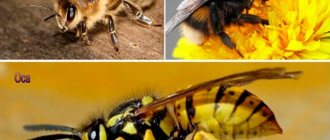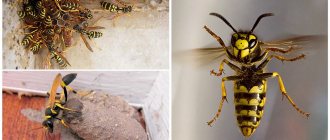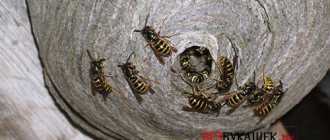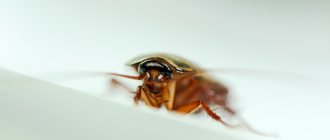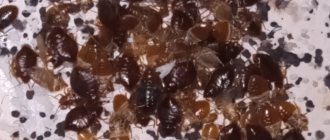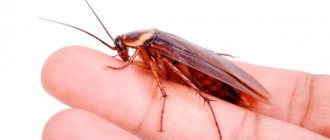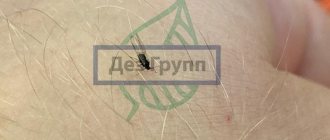If you belong to that group of gardeners who, at the mere mention of these stinging insects, wrinkle their nose in disgust and immediately recommend proven means of getting rid of wasps and hornets, our material is for you. What if these insects are not only harmful, but also... useful?
Sergey Sidorenko, an experienced gardener from the Krasnodar region, who likes to share his practical knowledge and observations, offers to discuss this topic. According to him, “there are dozens of gardens created, thousands of seedlings grown, an extensive collection of plants, a book written, seminars and master classes.”
The rest of the story is told on his behalf.
The editorial position may not coincide with the opinion of the author of the material.
What is the difference between a bumblebee, a hornet, a wasp, a bee and their bites
It is more correct to say that insects sting and do not bite humans. Only female wasps, hornets, bumblebees or bees attack. Modified ovipositor - only females have a sting. It is located at the back of the underside of the abdomen. Piercing the body of the victim, the insect simultaneously injects poison through a cavity in the sting.
Wasp
At the end of summer, wasps swarm around fruit trees. The insect resembles a striped fly: a shiny black and yellow body 15 to 18 mm long, a shaggy small head with powerful jaws and two pairs of brownish wings. Between the abdomen and the sternum there is a thin joint, which is popularly called the “wasp waist”.
When a threat arises, the insect plunges a sharp, smooth sting into the human body, but does not leave it there. Having stung 1–5 times, the wasp flies away. Unlike other insects, sometimes a wasp can bite with its jaws. Such a bite does not cause serious consequences, since it occurs without the introduction of poison. Insects live alone and in colonies in paper nests consisting of egg cells.
The size of a wasp nest shows how many workers there are in the colony
Hornet
Some insects fly through the air like fighter jets. We are talking about hornets, which differ in appearance from wasps with a large head and rounded abdomen. At rest, the insect's wings fold along its back. The hornet stings like a wasp - without releasing its sting. Hornets build brown nests, while wasps build gray nests. Insects attack the one who tries to destroy the nest.
The top of the hornet's head is larger than that of a wasp and is brownish rather than black in color.
Like other social insects, hornets attack a family of people who threaten the nest. To mobilize relatives, the hornet produces an alarm pheromone.
Bee
Disturbed bees attack humans everywhere except Antarctica. The insect's body is dark with ocher stripes, hairy and more rounded than that of a wasp. The proboscis-shaped mouth is used to suck nectar from flowers. The difference between a bee is that its sting is not removed after a sting, but remains in the wound along with part of the abdomen, which pulsates, continuing to inject poison. Due to damage to a vital organ, the insect dies within 3 minutes.
Villi on the body of a bee help the adhesion and transfer of plant pollen
Bumblebee
The largest of the stinging striped insects are bumblebees. Their bodies are larger, rounder and fluffier than those of bees and wasps. The stripes on the black belly are orange or yellow. The difference from other insects is the pollen baskets on the hind legs, surrounded by hard, straight hairs. The mechanism of a bumblebee bite is similar to that of a wasp and a hornet: the sting is smooth and does not remain in the wound.
The genus Bumblebees belongs to the family of true bees.
How to understand who bit
When examining the bite site, they find out whether the wound is clean. If a black sting with jagged edges, like a saw, is found in the wound, it means that the person has been punished by the bee for his carelessness. But other insects also leave sting fragments if you swat them at a crime scene. In the absence of a stinging weapon, it is impossible to understand who bit, since the reaction of each person’s body is individual.
The biting insect is indirectly determined by the degree of pain of the bite. But anyone who has suffered at least once from stinging insects can make comparisons. The most painful sting is from the hornet, followed by the wasp, bumblebee and bee.
A hornet's sting is less toxic than a bee's, but it can sting several times.
If a person has not encountered these insects before, it is worth monitoring the speed and severity of the allergic reaction. The most powerful poison is the wasp, which quickly enters the bloodstream and causes illness. At the sting site for 3–15 minutes. edema develops.
A bee sting is characterized only by local manifestations. The swelling from the bite is smaller and grows more slowly. True, in the event that a person does not suffer from individual intolerance.
Behavior
A wasp and a bee can live in a group, accumulating up to several thousand individuals and alone. The queen begins to build a wasp's nest; first she builds one layer, then the rest. She then mates once with the drone and begins laying larvae, providing food.
At the beginning of summer, the female lays larvae, from which sterile individuals hatch. Closer to autumn, the larvae from which individuals will emerge are capable of reproduction. They develop in a cell, feeding on pre-prepared immobilized insects. Sometimes wasps lay larvae in the body of large beetles. During its development, its status gradually increases. She starts with cleaning the nest and ends with getting food. In autumn, all ordinary individuals and drones freeze, leaving only the queen alive.
In a bee swarm there is also a clear division of responsibilities. Some individuals deliver nectar to the hive. Others put nectar in honeycombs, while others clean the hive of dead individuals. There are cell cleaners, caring for babies and guards who stand at the entrance, the job is to not let strangers through. Defenders protect the home from attackers, these include humans and bears.
Each ordinary worker gradually goes through all the stages of the listed works throughout her life. This is how nature prescribed it. The young individual begins by cleaning the honeycomb. Then she produces milk and begins feeding the queen and young larvae. Then the bee feeds the older larvae with beebread. Then it takes nectar from collecting bees, or stores it in cells. Then the time comes for her to remove the garbage, when her wax glands begin to work, she begins to build and plug the honeycomb. After the 18th day, the glands that produce poison begin to act, then they are trusted to protect the hive.
The bee colony accumulates a supply of beebread for the winter months and for inclement summer days. Closer to autumn, when there is little food, they destroy the drones.
The queen flies out into the wild to mate. In free flight, she chooses a more viable male, sometimes from another hive.
Symptoms of bites
Regardless of the design of the stinging apparatus, the bite of a wasp, hornet, bee or bumblebee is accompanied by similar symptoms: swelling, redness and pain in the affected part of the body.
Edema
An allergic reaction to insect venom develops at the site of the bite. The skin becomes numb and swells. As toxins spread through the vessels, the area of swelling expands. How many days the swelling on the skin will last depends on the individual reaction to the poison.
The skin at the site of a stinging insect bite swells
red spot
At the site where the skin is punctured by a sting, a red, swollen spot appears, in the center of which there is a point with a depression. Over time, the skin around the wound turns pale and thickens, and the red spot increases in size.
Depending on the sensitivity of the body, the red spot from the bite can last up to a week
Itching
After being bitten by stinging insects, the skin becomes inflamed and itchy. Body temperature in the sting area increases. The listed symptoms are associated with the toxic effects of insect venom. But you should not scratch the skin to avoid infection.
Pain
An insect bite feels like being pricked by a sharp needle. Then the feeling of burning pain grows, like a burn. After 2–3 hours, the severity of the pain decreases. When a bee stings a person who is hypersensitive to bee venom, convulsions, pain in the lower back and joints appear.
Nest arrangement
Bees build their hive from wax (they secrete it themselves), making strictly symmetrical honeycombs inside. Domestic bees live in special houses that beekeepers build for them. A hive of wild bees can be located in a hollow tree or in a crevice of a steep rock.
Wasps make their home from parchment, which is made by chewing wood or other plant cellulose. Their hive is round in shape, gray in color, and looks papery. Wasps attach the hive to the branches of a tree or the ceilings of rarely visited buildings, and sometimes they build it in the ground.
The nest of bumblebees is called a bombidarium; insects make it in burrows of small animals, hollows, and abandoned bird nests. Bumblebees, like bees, build the first cells of their nest with wax. To construct subsequent cells, they use capsules of already hatched larvae.
Treatment for normal reactions to bites
What is more important is not the name of the culprit of the sting, but the nature of the reaction to the bite, since the treatment of wounds from any stinging insects is the same.
First aid
First of all, the victim is taken away from the site of the insect attack, placed in a horizontal position, and the collar and belt on the waist are loosened. Even with a normal reaction to insect venom, with multiple bites or stings in the area of the face, neck, mucous membranes, first take allergy pills.
If there is a sting in the wound, rub it with a napkin using stroking movements or pry it with a blunt object with a thin surface: a table knife or a bank card. If you grasp the sting with tweezers or your fingers, the remaining venom will be squeezed into the wound.
The bee sting must be carefully removed without applying pressure.
Then the following steps are performed:
- the wound is washed with running water and soap;
- treated with an antiseptic: hydrogen peroxide or alcohol;
- neutralize the poison with a lotion of lemon juice, vinegar solution: 1 tsp. per glass of water.
To reduce the rate of spread of toxins, apply a heating pad or plastic bag with ice to the affected area of skin for 10–12 minutes.
An ice compress for bites can be applied 3 times a day, pausing for 3 hours.
What to do if you are bitten by stinging insects - video
Drug treatment
To alleviate the patient's condition, the bite site is lubricated with ointments containing analgesic and anti-inflammatory components. Medicines used:
- Fenistil cream-gel relieves allergies, pain, itching;
- Menovazin solution or ointment provides long-term pain relief to the bite site;
- Boro Plus cream heals the wound and restores the skin;
- Levomekol ointment disinfects and relieves inflammation;
- tincture or ointment with calendula resolves swelling;
- Zvezdochka balm relieves pain.
Vietnamese balm Zvezdochka quickly relieves itching from wasp, hornet, bumblebee and bee bites
Folk remedies
The symptoms go away on their own within 2–4 days, but the bite site hurts and itches. Folk remedies are applied to the wound:
- a paste of baking soda and water is left until dry;
- half a fresh onion for 20 minutes;
- cube of wet refined sugar for 30 minutes;
- keep menthol toothpaste or foam laundry soap for 5 minutes;
- a napkin moistened with aloe or raw potato juice;
- salt compress: 1 tsp. salt per glass of water;
- plantain leaf.
Aloe juice soothes irritated skin and relieves swelling
Complications and consequences of bites
The outcome of insect stings is unpredictable. The consequences depend on the following circumstances:
- predisposition to allergic reactions;
- age of the victim;
- number of bites;
- chronic diseases;
- physical condition.
It is dangerous to get attacked by several hornets. Insects inject a lot of acetylcholine into the victim's body, which slows down the heart. After a multiple attack, the victim is immediately taken to the hospital.
When microbes enter the wound, a secondary infection sometimes develops after 2–3 days. The bite site becomes infected, ulcers appear, and inflammation expands. The complication is treated with local antibiotics, for example, Levomekol or Tetracycline ointment.
Tetracycline ointment is applied to the site of the inflamed bite 2 times a day
Allergy to bites
You should take treatment seriously if you have or have had a severe allergy to insect venom. Medical observations show that each repeated bite causes a more severe reaction than the previous one. With individual intolerance or repeated stings, Quincke's edema or anaphylactic shock sometimes occurs. Similar reactions develop immediately after an insect attack or within 1–5 hours. In the absence of medical care, a person falls into a coma or dies.
A severe allergic reaction is characterized by:
- pronounced swelling at the site of the bite;
- itching spreading throughout the body;
- decreased blood pressure, pallor;
- dizziness to the point of loss of consciousness;
- headache;
- nausea, vomiting and diarrhea;
- difficulty breathing;
- increased sweating;
- cramps and chills;
- constriction of the pupils.
Constriction of the pupils is one of the signs of a systemic allergic reaction in humans
Allergy treatment
If severe allergy symptoms appear, take allergy pills immediately. For example, drugs:
- Zyrtec;
- Claritin;
- Suprastinex;
- Tavegil;
- Cetrin;
- Erius.
The allergy medicine Zyrtec is intended for adults and children from 6 months.
In case of severe swelling, hormonal ointments are applied to the site of inflammation:
- Sinaflan;
- Hydrocortisone;
- Elokom.
Due to side effects, the use of these products is allowed only after consultation with a doctor.
In case of alarming signals - breathing problems and confusion, immediately call an ambulance. To prevent a decrease in blood pressure, the patient is given 25 drops of Cordiamine. Before the doctors arrive, the victim is given sweetened water or tea.
Tea with sugar will give strength to the victim and help remove toxins from the body.
If help has not yet been provided, the visiting doctors give injections sequentially:
- a drug that prevents a decrease in blood pressure - Cordiamine (2 ml) intravenously;
- antihistamine - Tavegil or Suprastin (2 ml) into the gluteal muscle;
- hormonal - prednisolone intramuscularly (2 ml).
Table: Treatment of insect bites depending on the location of the lesion
| Bite site | Treatment |
| Finger | To reduce swelling, place your finger in a thick soda solution: 1 tbsp. l. soda to 1/2 cup water. |
| Hand | Apply an antiseptic, apply an ice compress, and raise your hand. |
| Leg | Apply a tourniquet above the bite site, take an antihistamine, apply ice, and drink plenty of water. |
| Eye, mouth, neck | Call an ambulance, take anti-allergy medication, apply ice. |
Features of treatment of bites in children
Children who are stung are treated in the same way as adults: the wound is disinfected and a cooling compress is applied, anti-inflammatory and analgesic ointments, except hormonal ones, are used.
For wasp, hornet, and bumblebee bites, the child’s skin is lubricated with anti-inflammatory ointment 3 times a day
Then they carefully monitor the condition of the victim to see if an allergy has arisen - large swelling. In this case, an antihistamine is given in the pediatric dosages indicated in the instructions. If the baby’s condition does not improve within 1–2 days or the wound festers, you should visit a doctor.
Call an ambulance immediately if:
- a child under three months;
- the bite was on the neck, face;
- breathing is difficult, a whistle escapes from the throat;
- there is dizziness;
- coordination of movements is impaired;
- bites are numerous;
- pain in the heart area;
- the victim cannot speak or eat, which indicates swelling of the larynx.
If a child is bitten on the face, he needs urgent medical attention.
The risk group also includes children who suffer from diathesis, psoriasis, bronchial asthma and other diseases of an allergic nature.
A friend of mine was bitten on the tongue by a wasp as a child while he was eating a sandwich. It was on a remote sea beach, it took a long time to get to the doctors. A man standing nearby took an empty bottle and swam into the sea. The boy rinsed his mouth with the sea water he brought and the swelling of his tongue quickly went away.
Behavior in stressful situations
It is important for everyone to know that the behavior of these insects depends on the influence of various factors. You can anger both some insects and others. Bees always protect their hive, which contains the queen. In case of penetration into the hive, the bees immediately, as a whole family, come to the defense. Wasps act in much the same way and if their nest is attacked, you can get numerous bites. There is an opinion that wasps can attack just like that, but this is rather a myth. They sting only if they are provoked, otherwise wasps can fly and not hurt anyone. In any case, you need to be careful with both bees and wasps.
Treatment of bumblebee and other insect bites in animals
Due to their natural playfulness, cats and dogs sometimes find themselves in dangerous situations: they suffer from stinging insects, including bumblebees. If the animal is not allergic and the paw was stung, there is no need to panic. The bite site is checked for the presence of a sting and removed by running a napkin over the skin. Then the wound is treated with an antiseptic and cold is applied. After 2-3 days the swelling will go down.
But they urgently take the animal to the veterinarian if:
- the victim is a puppy or kitten; intoxication can be fatal;
- Previously, high sensitivity to insect poisons was observed;
- coordination is impaired, shortness of breath and vomiting appear;
- a bumblebee or other hymenopteran insect has stung the lower abdomen, neck, muzzle or tongue.
When bitten in the face, there is a high risk of suffocation due to swelling of the mucous membranes of the nasopharynx. A sting in the lower abdomen can lead to blockage of the urinary tract.
If your cat's nose is stung, take it to the vet immediately to avoid suffocation.
Veterinarians stop the development of edema with an intramuscular injection of prednisolone (0.5 ml) or Dexamethasone (0.2 ml). Then an antihistamine is prescribed: Benadryl (suitable even for kittens) or Diazolin - half a tablet at a time. When there are no other medications, Suprastin is prescribed, but the drug sometimes causes an immune response in animals.
Long-haired cat breeds more often suffer from allergies to insect bites: Angora, British and Persian.
The best mosquito repellents
What can we do to prevent mosquitoes from using us as an all-you-can-eat buffet? The chemicals diethyltoluomide (DEET) and picaridin (icaridin or saltidin) are very effective; they repel mosquitoes (and ticks too) for six hours. However, DEET has an irritating effect on mucous membranes and the nervous system, so it is not recommended for young children and pregnant women. Picaridin is somewhat less aggressive, but still far from a biological substance.
Unfortunately, biomaterials are not the best alternative in this case, because they are much weaker than synthetic ones. They wear off quickly and need to be reapplied every two hours.
Biomaterials such as coconut oil, plant essential oils: citronellol, tea tree oil, extracts of lavender, eucalyptus, cloves, geranium, cedar, basil, garlic, peppermint - may smell unpleasant to the human nose, but they are not toxic. However, contact with some of these natural aromatic substances may well cause allergies. The body will be most reliably protected by a mechanical barrier: long clothes and mosquito nets.
Precautionary measures
Do not delay treatment: if a strong reaction to a sting occurs, you should consult an allergist.
When treating a bite, the following are not allowed:
- attempts to suck or squeeze out poison from the wound;
- picking with a needle;
- rubbing or scratching the skin;
- cauterization of the bite point;
- applying earth.
The suffering of the bitten person is not alleviated by alcohol. To improve your well-being, it is better to lie down and place a salt or cold compress on the bite site. Physical activity is prohibited.
If you drink alcohol after being bitten, the poison will spread throughout the body even faster.
